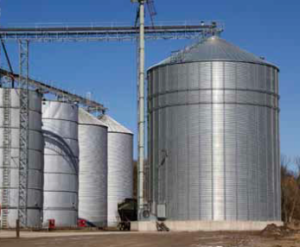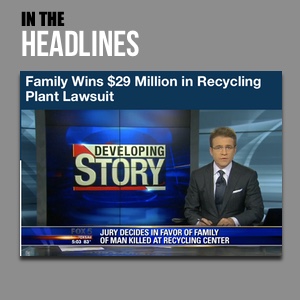
(OSHA)
Grain handling plants receive, manage, store, process, and ship a variety of raw agricultural goods, such as, corn, wheat, oats, barley, sunflower seeds, and soybeans.
The U.S. Occupational Safety and Health Administration (OSHA) considers the grain handling industry a “high hazard industry where workers can be exposed to numerous serious and life threatening hazards.”
Grain Handling Hazards
- Fires and explosions from grain dust accumulation
- Suffocation from engulfment and entrapment in grain bins
- Falls from heights
- Crushing injuries and amputations from grain handling equipment
- Unhealthy levels of airborne contaminants, including molds, toxic chemicals, and gases
Real Stories
OSHA warns, “Suffocation is the leading cause of death in grain storage bins. In 2010, 51 workers were engulfed by grain stored in bins, and 26 died – the highest number on record.”
OSHA highlights one such tragedy: Two young workers (ages 14 and 19) were killed at a grain storage facility in the Midwest when they were sent into a grain bin to “walk down the corn.” The grain bin was being emptied, and the workers’ task was to break up clumps by walking on them to make the corn flow out of the bin. The workers were not provided safety harnesses, and the machinery used for evacuating the grain was running. The suction created by the flowing grain pulled them in like quicksand and suffocated them. Workers should never be inside a grain bin when it is being emptied out, because a sinkhole can form and pull down the worker in a matter of seconds. OSHA standards prohibit this dangerous practice. This company ignored that rule as well as other protective safety requirements. In addition, child labor laws made it illegal for this company to employ a 14-year-old to work in a grain silo.
Employer Responsibility
Employers must provide a healthy and safe workplace for their employees. OSHA encourages employers to implement and enforce safety guidelines to address the numerous potential hazards of grain handling and to reduce employee injury.
To prevent another suffocation tragedy, like the one above, employers must:
- Turn off, disconnect and lock out all powered equipment associated with the bin that poses a danger to employees inside the grain structure, including augers used to help move the grain, so that the grain is not being emptied or moving out or into the bin [1910.272(g)(1)(ii)]. Standing on moving grain is deadly; the grain can act like quicksand and bury a worker very quickly. Moving grain out of a bin creates a suction that can swiftly pull and bury any workers who are in the bin.
- Prohibit walking down grain and similar practices where an employee walks on grain to make it flow [1910.272(g)(1)(iv)].
- Provide each worker entering a bin from a level at or above stored grain, or when a worker will walk or stand on stored grain, with a body harness. The body harness should have a lifeline that is positioned and is of sufficient length to prevent a worker from sinking further than waist-deep in grain [1910.272(g)(2)].
- Provide an observer stationed outside the bin or silo being entered by an employee and maintain communication between the observer and the employee who enters. Ensure the observer is equipped to provide assistance [1910.272(g)(3)].
- Prohibit workers from entry into bins or silos underneath a bridging condition, or where a build-up of grain products on the sides could fall and bury them [1910.272(g)(6)].
- Provide training about engulfment and mechanical hazards to employees assigned special tasks such as bin entry [1910.272(e)(2)].
- Test the air within a bin or silo prior to entry for the presence of combustible and toxic gases, and to determine if there is sufficient oxygen [1910.272(g)(1)(iii)].
- Provide and continue ventilation until any unsafe atmospheric conditions are eliminated. If toxicity or oxygen deficiency cannot be eliminated, workers must wear appropriate respirators [1910.272(g)(1)(iii) A and B].
- Ensure a permit is issued for each instance a worker enters a bin or silo, certifying that the precautions listed above have been implemented [1910.272(g)(1)(i)].
Employee Rights
OSHA reminds workers, they have the right to:
- Working conditions that do not pose a risk of serious harm.
- Receive information and training (in a language and vocabulary they understand) about workplace hazards, methods to prevent them, and the OSHA standards that apply to their workplace.
- Review records of work-related injuries and illnesses.
- Get copies of test results that find measure hazards.
- File a confidential complaint asking OSHA to inspect their workplace if they believe there is a serious hazard or that their employer is not following OSHA’s rules.
- Exercise their rights under the law without retaliation or discrimination.
We Fight for Victims of Workplace Accidents in Georgia …Contact us Now for a Free Consultation.
 The Murray Law Firm has recovered millions of dollars for victims of unsafe workplaces in Georgia, and recently obtained a $29.25 million dollar verdict for one of our Clients in Fulton County State Court.
The Murray Law Firm has recovered millions of dollars for victims of unsafe workplaces in Georgia, and recently obtained a $29.25 million dollar verdict for one of our Clients in Fulton County State Court.
We represent our Clients on a contingency agreement, which generally means that no fees or payments are owed until and unless we recover. Anyone seeking further information or legal representation is encouraged to contact us via e-mail (click here) or by telephone at 888.842.1616. Consultations are free and confidential.
Choosing the Right Attorney
Selecting the right attorney for you or your family is highly important. You must feel confident that the attorney you hire has a complete understanding of the law applicable to your particular case, and has successful experience in handling such cases.
Important: Do not hire a lawyer who has violated the Rules of Professional Conduct!!!
You should not hire an attorney who calls you or visits you unsolicited, or anyone that contacts you directly to offer legal services. This activity is strictly prohibited by Rule 7.3 of the American Bar Association (ABA) Model Rules of Professional Conduct, which states as follows:
 A LAWYER “SHALL NOT” CONTACT A PROSPECTIVE CLIENT THROUGH A “LIVE TELEPHONE” OR AN “IN-PERSON” VISIT.
A LAWYER “SHALL NOT” CONTACT A PROSPECTIVE CLIENT THROUGH A “LIVE TELEPHONE” OR AN “IN-PERSON” VISIT.
– RULE 7.3, ABA MODEL RULES OF PROFESSIONAL CONDUCT.
If an attorney, or someone acting on behalf of an attorney, contacts you in this manner, that attorney is in violation of this Rule. This unethical and unprofessional activity on the part of the lawyer is good sign that you should stay away. It is imperative that you are represented by an attorney who is capable of advocating for you within the confines of the law, and an attorney who fails to abide by the Rules of Professional Conduct is probably not the best fit. In fact, any such attorney should be immediately reported to the local State Bar Association. If you have been contacted in such an unsolicited manner, contact us and we’ll assist you in filing a report.

Contingency Fees Disclaimer: “Contingent attorneys’ fees refers only to those fees charged by attorneys for their legal services. Such fees are not permitted in all types of cases. Court costs and other additional expenses of legal action usually must be paid by the client.”
 Georgia Legal Report
Georgia Legal Report


